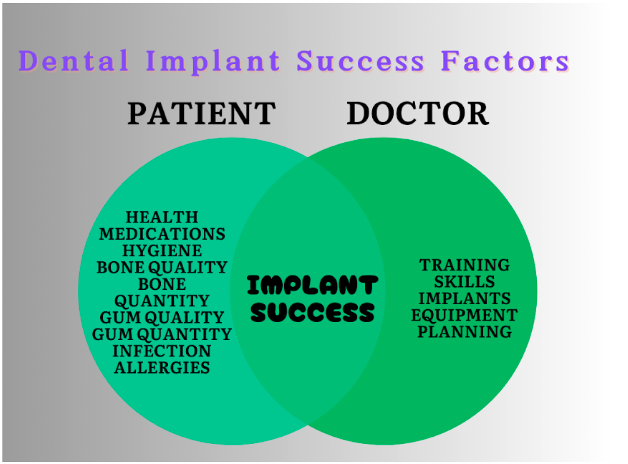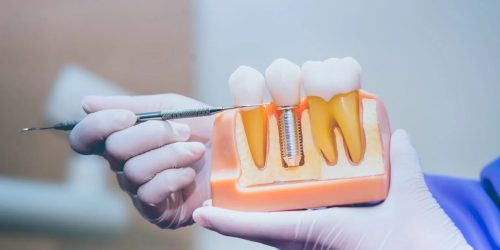15 Factors that Determine How Long A Dental Implant Will Last
One of the most common questions I get is “How long do teeth implants last? I don’t want to invest all this money and then have to start all over a few years down the road.” This is a fair and valid question. And the answer is…it’s complicated! First, dental implants work. There are a lot of scientific articles that have shown they have a 95%+ success rate after 10 years in someone’s mouth. For this article, we will be discussing the unfortunate 1-5%. To answer the question “How long do dental implants last?”, we’ll have to talk about when they don’t work. We’ll talk about when implants can have issues, what these issues are, and how the patient and doctor fit into the equation. Buckle up, this is going to be a long one as there’s a lot to unpack here. (Learn how Vitamin D may help with dental implant success.)
The Two Kinds of Dental Implant “Failures”
A full on failed dental implant is categorized by two different time periods, and we dentists usually call them “early” or “late” failures. To understand what these mean, let’s briefly discuss the implant process.
Your dental implant surgeon will place an implant in your bone where you want a tooth or teeth. Depending on the specific situation, your surgeon will screw a part into the implant, and your gums may grow over it, or you may be able to see it. They may also make a temporary tooth that gets immediately attached to the implant. Regardless, the implant is now in the “healing period”. This is a very important time for the implant. At this time, it is staying in place only by the bone squeezing against it, similar to a screw in wood. The bone has not yet fused to the implant. Over the next 3-6 months, the bone will begin changing and go through the process of physically connecting to the implant. After that process is complete, and your implant is now attached to your bone, your final tooth or teeth will be connected to the implant. At this point the process is complete and you can use the implant tooth like a normal tooth.
Early Failure
With that process in mind, we call it an “early failure” when the bone does not fuse to the implant during the healing period. Sometimes, we can see it on an x-ray. Other times, your dentist will go to take a part out of it or tighten a part down and the implant moves or even comes all the way out. If an implant moves after it has been in the bone for a few months, there is nothing that can be done to save it. The process must be started from the beginning again. Your body has rejected the implant. This is typically what we consider an “early failure”. These are often a mystery as to why it happened.
Late Failure
Now, let’s say the implant healed well, and then your dentist attaches a tooth to it. You use it for a while like you would any other tooth. Here are a few different scenarios of what a “late failure” can look like:
- You have noticed you’ve been having pain on or around the implant. You go to your dentist and she takes an x-ray. She tells you that there is significant bone loss around the implant and it will have to be removed.
- Imagine the same basic scenario as above, but you never felt any pain around the implant. It seemed completely normal.
- You go to your regular cleaning and have no symptoms. Your dentist tells you there is a small amount of bone loss. The situation is monitored, or maybe he or she recommends some sort of therapy, but you aren’t ready to do it yet. Your next cleaning comes around and it has a little more, then a little more, then a little more. Finally, the bone loss becomes too significant that no procedure can save it and it needs to be removed.
- One day at home you feel something loose. You tug on the tooth that is attached to the implant and the whole thing comes out…YIKES!
There are an infinite amount of situations, but you get the point. Things were good for a while, then all of a sudden they are not, which is what we call a “late failure”. Sometimes we can figure out why it happened, so we can try to avoid it next time. We often have more information to go off of vs “early failures”.
Again, I’d like to emphasize that implants work really well and are highly successful. I just want to be honest about how and when things can go wrong because there are those unlucky few. If these kinds of issues happened all the time, I would have given up on implants a long time ago!
Bone Loss Around Dental Implants
Let’s touch on bone loss for a moment here. The term “bone loss” gets thrown around a lot on social media groups and other implant discussions a lot. First of all, I would like to highly recommend AGAINST posting your x-rays on any sort of public forum and asking for advice. I see this happen regularly, and it gets a ton of responses from people. But it almost always has people saying that it looks bad for whatever reason, there is bone loss, etc etc. Most of the opinions are flat out wrong and the majority are negative even if there is nothing wrong on the x-ray. It’s similar to when you have a stomach ache, head to WebMD to investigate, and diagnose yourself with six different kinds of cancer. You head to your doctor to report the findings, and, as it turns out, you just needed to take a couple of tums. The point is, please leave the x-ray interpretation to the experts. It takes time and a lot of reps to understand everything going on with an x-ray. Bone can look different around different implants, and it can even look different around the same implant depending on what part of the treatment process it is in. It’s a complicated thing.
Anyways, bone loss around implants is a very complex topic. There are whole textbooks written about it. You only really need to know a couple of things. First, a little bone loss around an implant is very common, and can stay stable indefinitely. It is not the kiss of death. Second, it is extremely difficult to treat if the loss of bone is significant. It often involves a laser, bone graft, and gum graft. This is one reason why if your dentist recommends a bone or gum graft before or during placement of an implant, you should do it then. Don’t wait until something potentially goes wrong later because it becomes much less predictable. Trust your dentist! They have likely seen your situation before, and are making these recommendations for a reason.
Sometimes, your dentist may recommend removal of the implant and starting over instead of trying to remedy the current situation. This is often a better option because once it is removed and the area is healed, it becomes much easier to work on that area and also much more predictable.
So the question is…what truly affects if the dental implants will work or not?
We’ll split these items into two major categories, which we’ll call “doctor factors” and “patient factors”. I won’t cover every single thing, but I’ll list some biggies. We’ll take a shallow dive into these two categories, and a few items that apply to both categories. Like I said, this can get very complicated.
Patient Factors
- Overall Health – This is a huge factor, especially as it changes over the long term. Many diseases or health issues can cause problems for implants. Something like diabetes can cause delays in healing. Autoimmune issues can cause many unwanted problems. Blood pressure can cause a delay in surgery if it isn’t under control. The list goes on and on. You really should get your house in order before undergoing any medical procedure, and implants are certainly no exception to that statement.
- Medications – This category goes hand in hand with the first. There are some medications that lower the success rate of implants, such as mood altering medications like SSRIs. Other medications like bisphosphonates cause implant procedures to be extremely high risk. Some really nasty infections can happen if you have some type of dental surgery and are taking bisphosphonates. Blood thinners can cause lots of bleeding and should be approached with caution. They can also make it very hard for the surgeon to see during surgery, which ups the level of difficulty.
- Oral Hygiene – A clean mouth is a healthy mouth. There are tons of bacteria in the mouth all the time, even in someone with no teeth. It is imperative that implants are cleaned well if you want them to last a long time.
- Bone Quality – Good, healthy, strong bone is an important factor for short and long term success. In general, better bone quality means the implant will go in tighter, and therefore last longer. This is another one of those complicated factors that I have oversimplified here.
- Bone Quantity – The more bone you have, the easier it will be for your surgeon to place the implant in the right spot. When an implant is placed in the right spot with a lot of bone around it, success rates skyrocket.
- Gum Quantity and Quality – The black sheep of implants that no one wants to talk about. Gums are extremely important around implants. Strong thick gums greatly increase the longevity of implants. Gum grafts are common in areas where teeth have been missing for a while, and they are a great investment in the longevity of your implant.
- Prior Tooth Infection – This can complicate things for a couple of reasons. The first is that an infected tooth usually has a lot of destruction of bone around it, specifically at the end of the root. Second, there are often bad bacteria in these infections, so they need to be cleaned well before an implant or bone graft can be placed.
- Teeth Alignment – There are times when implants aren’t possible simply because other teeth are in the way. If you have an empty space and you want an implant, get a hand mirror and good lighting and look at the space. Imagine what that space would look like if there was a perfectly shaped tooth there. Now bite down and see if the opposite tooth (from either the top or bottom) fits in the space where you want your new tooth or teeth to be. If it does, then it is in the way, and you will likely require more complicated and costly treatment to remedy that issue. Implants need to have enough space from side to side and from top to bottom.
- Allergies – Sure an allergy to a metal in an implant can be an issue, but that is very rare. I’ll write about that topic soon. Something much more common, though, is a penicillin allergy. We ALL know someone with a penicillin allergy. Amoxicillin is the most common antibiotic given prior to implant surgery and for a few days following. It’s the best and most effective. If you are allergic, an alternative will have to be used, which usually isn’t as good. This isn’t a huge deal, but it is an example of how many little things contribute to implant health and longevity.
- Smoking – Stop smoking!!! I know you’ve been wanting to. You can do it!
Doctor Factors
- Training – There are lots of ways and places for your doctor to learn about implant placement and attaching teeth to implants. It’s not a bad idea to ask a few questions about your doctor’s training. There are weekend courses, there are year long courses, there are residencies, and a plethora of other ways to learn implants. Any of these can be adequate. Your doctor should be confident answering this question and you should feel confident in his or her answer.
- Skills – As you can imagine, this can be very difficult to figure out as a patient. Like any other profession, skills vary from doctor to doctor. If you can find some case photos, referrals, or ask other dentists about them, that could help you figure out this part of the equation.
- Implants – Most conventional titanium implants these days work very well. There are a lot of different brands, and big name companies are typically very high quality. If you can find out the brand of implant your doctor places, you can google it and make sure it is a reputable company. Now, that was pertaining to conventional titanium implants. There are also other styles of implants such as zirconia implants, mini implants, and basal implants. I don’t recommend those, and I’ll write about why another day.
- Equipment – The equipment your doctor uses can be important. If they are using brand name equipment from a reputable company, there should be no issues. There are a few things the doctor should do that can help with implant healing. For example, we have to drill a small hole in your bone that the implant will be placed into. Over time, these drills get dull. When they are dull, they get hot, which can damage the bone. To combat this, your doctor should be using new drills after a certain amount of uses, which is different for every implant company. Obviously, this information can be hard to find out.
- Planning – Your doctor should have a plan going in! Figuring things out after the fact is very hard and can lead to some tough situations. In my opinion, this is one of the benefits of having a General Dentist place your implant, because they will have a plan of what the final outcome should be with the tooth. If you are sent to a surgeon that only does surgery, there can sometimes be a disconnect, and they can’t visualize what the final outcome should look like.

This topic isn’t all sunshine and rainbows, but it is an important part of implants. Overall, I want to stress again that implants are extremely successful. Even when patients have compromised health and other issues, and the doctor messes up a step, dental implants still find a way to work for a long time. As you can see, answering the question “How long do implants last?” is impossible. It’s a complex process that is different for everyone. At the end of the day, we are working on the human body, and there are many factors involved. (Read about Vitamin D, the one free vitamin you need for dental implant success.)
All advice is my opinion and you should seek professional medical advice from your physician before taking any action.
– Blake Vidrine, DDS





